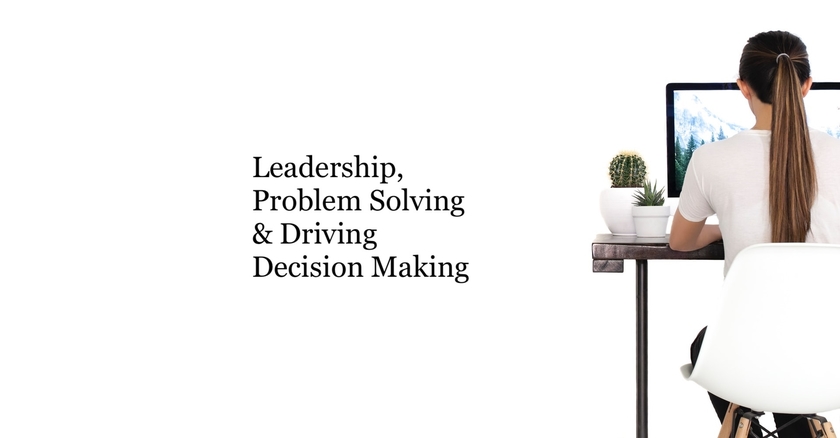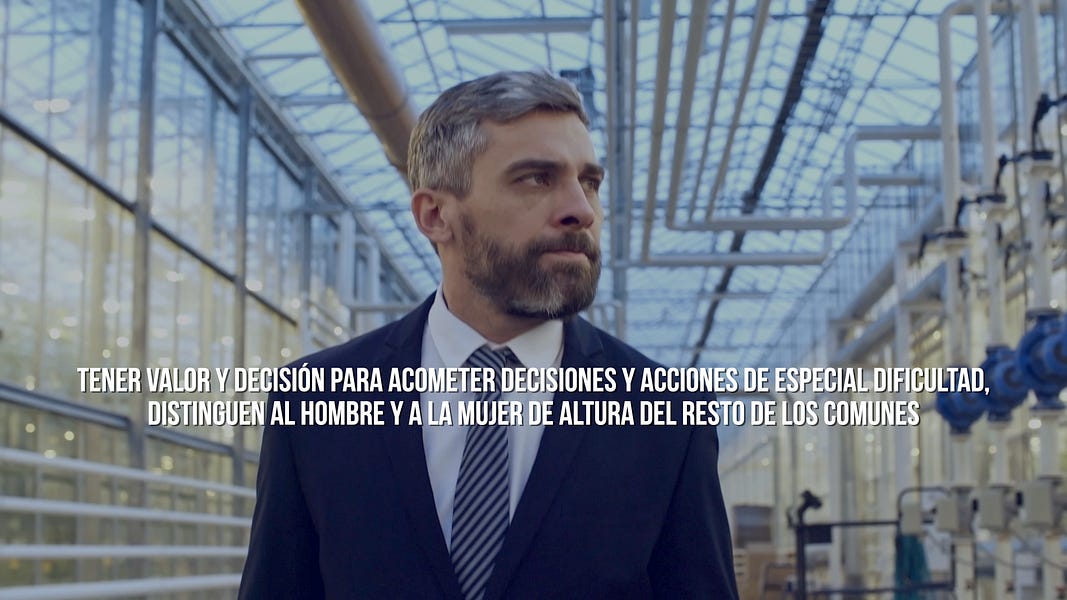The Leader has 2 Systems for the Resolution of the Problems of the Organization. One that we are going to develop in this article - video is "Individual Problem Solving by the Leader".
And the other one is "Group Problem Solving led by the Leader", where the Synergism, the Knowledge, the Creativity, and the Involvement of the group with the Organization are taken advantage of.
We have already developed several Videos on our Channel on this topic. In any case, the leader, in addition to many other things, must be a good "Problem Solver". Let's introduce ourselves to this essential topic for the Leader of the "Leadership, Problem Solving, and Driving Decision Making."
Let's start by developing the structure of the system and the 5 Phases, of which Problem Solving consists.
1 - Analytical Phase.
A) Define the problem to be solved and the objectives.
B) Put the problem in a logical order.
C) Find the Causes.
2 - Creative Phase.
It is necessary to separate Creation / Evaluation / and Decision.
3 - Evaluation Phase.
A) Determination of Criteria.
B) Evaluation of Solutions.
4 - Decision Phase.
A) Preliminary Decision.
B) Consultation Period.
C) Final Decision.
5 - Follow Up Phase.
1 - Let's start with the ANALYTICAL PHASE.
First of all, what we have to do is:
A) Define the problem to be solved and the objectives.
Analyze and try to find the root, the key to the problem.
It is very common to direct the Problem Analysis towards a Solution instead of trying to find out the "reasons why the problem exists", that is to say, to find the true Causes of the Problem.
For example: The problem presented to us in this Example is that "We need to improve the Sales Results of a salesperson on our team".
Therefore we have to analyze him.
Questions to ask ourselves:
1 - How are we going to improve his results?
2 - How are we going to improve the sales of a certain product in that man or woman?
It is necessary to define exactly what we want to do, before tackling the solution to the problem.
It is better to have a mediocre solution to the right problem.
Not the right solution to the wrong problem, because this would create new problems.
Often we can also be paralyzed by a problem that is too big.
It would then be wise to divide it into smaller parts and attack them in an orderly fashion.
Therefore:
B) Put the problem in a logical order.
If we have already defined the objective, the question will be:
What is the structure?
Before tackling the problem, we must break it down into as many small elements as possible.
Working backward in an analytical way.
We have already seen in other previous Videos that the Sales Result of a seller is a consequence of his Performance.
And that is a first analysis of the performance of the seller, we can break it down into the three dimensions of the sale:
Which are 1) The Quantity of effort, 2) The Direction we give to those efforts, and 3) the Quality we put into those efforts.
And as we have already indicated in those previous Videos, those Three Dimensions: Quantity, Direction, and Quality, in turn, were broken down into what are the 10 Areas of Sales Activity. And that each of these 10 Areas can also be broken down into a multitude of elements that make up each of these 10 areas. So we enter a world of great complexity because ultimately all this is the sale that in itself is enormously complex.
C) Finding the Causes.
This part of the Analytical Phase of the problem is essential.
Here we must separate "facts" from "assumptions and opinions".
And for this we must apply the "four criteria of information" as they are:
The information we are analyzing is:
1 - Relevant, that is, of importance.
2 - Correct, i.e. true.
3 - Complete, i.e. total and not partial.
4 - Up to date, actual, that is to say, of the current moment we are living.
Once we have thought that we have found the different True Causes that are causing the problem, in a long process of Cause / Effect, we must inevitably "VERIFY" those Causes. In such a way that we cannot continue, in this process of Problem Solving, without successfully carrying out the Verification of the Causes that generate the Problem.
Once we know the real causes that generate the problem, we will move on to the second phase of the Problem Solving Process:
2 - The CREATIVE PHASE
We already know what are the True Causes of the problem we want to solve and we know it with certainty because we have verified and tested them correctly.
The question that arises now is:
What actions are we going to take?.
Are intelligent people usually more creative than others, and the answer is usually yes.
But some are not creative at all. Why?
Because they "kill ideas", they jump to conclusions too quickly, "perhaps killing seeds" of good ideas.
When everyone is concentrating on being creative, one idea produces or leads to another.
Even seemingly unrealistic ideas or unrealistic suggestions can lead to the birth of acceptable solutions.
Four important rules:
1 - Do not mix creative thinking and judgment, i.e. creative phase and evaluation phase.
2 - Make a list of possible solutions.
3 - Improve the solution we already have.
4 - Don't be afraid to include seemingly silly ideas on your list.
They may be seeds for other good ideas.
Let's avoid being negative, ironic, sarcastic in our thinking.
Avoid it in ourselves and avoid it in others.
And something of vital importance:
"We must separate Creation / Evaluation / and Decision."
Therefore in this Creative Phase 2, the objective is to find the solutions that will solve the Causes of the Problem already VERIFIED.
And for it, a good technique is that of realizing a "BRAINSTORMING", Technique that already we have developed in several Videos on:
Group Problem Solving, that is:
Philosophy and the Techniques for:
Teamwork and Group Problem Solving.
Let's now move on to the:
3 - EVALUATION PHASE.
We already have different Solutions to the established problem.
Example: Solution 1, 2,3,4.
Now in this evaluative phase, we enter the:
A) DETERMINATION OF THE CRITERIA, based on which we are going to evaluate the different Solutions.
As an example, the following could be chosen as criteria:
1 - Profitability.
2 - Greater security and less risk.
3 - Human factor.
4 - Comfort.
5 - Prestige.
Etc...
Now it might be useful to make a matrix, where the criteria were chosen are placed in the First Row of the Matrix, while the solutions are placed in the first column of the matrix, according to the DRAFT we show.
Our Matrix is going to allow us
(B) EVALUATE THE SOLUTIONS:
Based on the matrix developed we can assign values to each of the criteria, for example between one and five points, and thus be able to check which solutions are more suitable.
When evaluating the solutions we should handle the solutions that do not have limitations for this:
1 - Eliminate everything that is unrealistic, and
2 - Give the right weight to each Criterion.
Let's now move on to the next phase of Problem Solving:
4 - DECISION PHASE.
Preliminary Decision.
Do not start too early with this step.
The evaluation of all the solutions should be done first and certainly before anyone favors one or some of the solutions.
Beware of the vendor of your solution.
The Person who sells his or her solution with great conviction, flexibility, and technique.
A common way when there are several alternatives is to vote for the solution that seems to us to be the most successful.
The question is: is this right, what do we think?
Consultation Period
But who can say that the solution that the greatest number of people can understand and vote for is the most reasonable?
It is the leader who must lead, involve, and give voice to all until a good decision is reached and not stop until everyone is convinced.
Final decision.
Here we make the Final Decision.
And finally, we enter the last phase of Problem Solving:
5 - THE FOLLOW UP PHASE.
Great ideas and great programs and projects in the past "failed" for lack of proper follow-up.
Many good suggestions have been buried in the archives, partly because there are no Follow Up Managers,
or partly because they were simply forgotten.
Again, it is the leader who has the responsibility for the follow-up.
——
Thanks best regards.
JM.

15:00h en YouTube: https://bit.ly/38I1QgD
Aprovechando que ya ha comenzado la temporada de Fórmula 1, quisiera explorar en este vídeo cuál es la repercusión del Trabajo en Equipo, el “Team Building, Team Work” en el desarrollo de la Fórmula 1, ya que esta competición vive gracias a él, e impacta en el desarrollo de la tecnología del sector de la automoción a nivel mundial. Hablamos de “FORMULA 1 Trabajo en Equipo”.
#Formula1 #TrabajoEnEquipo #F1
3 CLAVES PARA INICIAR UN NEGOCIO EXITOSO.
Iniciarnos en un negocio nuevo o mejorar nuestro negocio para así poder tener éxito en el futuro no es tarea fácil; si no cualquiera lo haría.
Si algo he aprendido por mi profesión a lo largo de los últimos 40 años y más de 3000 días entrenando a equipos comerciales y de gestión empresarial, es que existen factores claves que pueden condicionar el éxito o el fracaso de un negocio.
Veamos tres claves para iniciar un negocio exitoso y que también es de aplicación si ya lo hemos comenzado pero queremos hacerlo crecer de una manera más eficaz.
Primera clave, conocer a la perfección tus recursos.
Segunda clave, como crearnos un plan de acción enfocado a la planificación estratégica.
Tercera clave, la clave del éxito es la perseverancia, la persistencia, la determinación.

La Psicología del Miedo | Desarrollo Personal.
Youtube video:
El Miedo es la reacción que se produce ante un peligro inminente.
El Miedo sirve para reaccionar y escapar eficazmente ante ese peligro inminente.
En el vídeo de hoy vamos a dar 5 Estrategias para enfrentarnos al Miedo.















